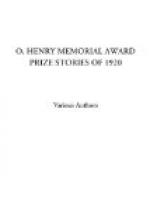The young Americans in “The Camel’s Back” support a critical thesis made for their author that he is evolving an idiom. It is the idiom of young America. If you are over thirty, read one of this prodigy’s ten-thousand word narratives and discover for the first time that you are separated by a hopeless chasm from the infant world.
“Professor Todd’s Used Car” and “Alma Mater” are two of the numerous stories published in 1920 which take up the cudgels for the undertrodden college professor. Incidentally, it is interesting to read from a letter of Mr. Lewis: “The brevity—and the twist in the plot at the end—were consciously patterned on O. Henry’s methods.”
Without further enumeration of the human types, it is a matter of observation that they exist in many moods and ages as they exist in real life. A revenant who lived one hundred years ago might pick up this volume and secure a fairly accurate idea of society to-day. A visitor from another country might find it a guide to national intelligence and feeling.
A few stories appealed to the Committee for their poetry. “The Funeral of John Bixby,” by Stephen Vincent Benet, and “The Duke’s Opera,” by “Jacques Belden” (the first an allegorical fantasy and the second a poetic-romance) are at the head of this division. With these should be included Don Marquis’s “Death and Old Man Murtrie,” for its sardonic allegory, and “The Designs of Miramon,” by James Branch Cabell, for its social satire. Individual members of the Committee would have liked to include these—different members preferring different ones of the four—but the Committee as a whole saw the allegory or satire or poetry predominant over story values.
The mysterious and the tragic are found in the work of Mildred Cram and Wilbur Daniel Steele. “Odell” and “Wind” illustrate Miss Cram’s particular genius in this direction: but “The Ember,” it is voted, ranks first of her publications. Mr. Steele’s “Both Judge and Jury” and “God’s Mercy” are exotic, perhaps, but the atmosphere he creates is beguiling in comparison with that of mere everyday. “Footfalls” was selected out of an embarrassment of riches offered by this author. The best horror story of the year is Rose Sidney’s “Butterflies.” It is a Greek tragedy, unrelieved, to be taken or left without palliation.
Athletics, no one will deny, constitutes a definite phase of American life. The sport-struggle is best illustrated in the fiction of Lawrence Perry, whether it be that of a polo match, tennis game, or crew race. “A Matter of Loyalty” is representative of this contest, and in the combined judgment of the Committee the highest ranking of all Mr. Perry’s stories. “Bills Playable,” by Jonathan Brooks, conceives athletics in a more humorous spirit.




